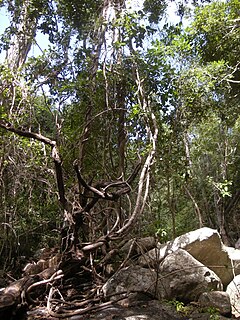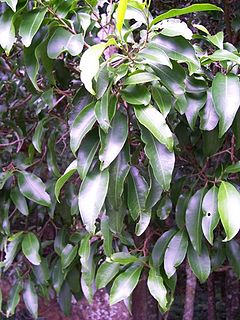
The Rhamnaceae are a large family of flowering plants, mostly trees, shrubs, and some vines, commonly called the buckthorn family. Rhamnaceae is included in the order Rosales.

A liana is a long-stemmed, woody vine that is rooted in the soil at ground level and uses trees, as well as other means of vertical support, to climb up to the canopy in search of direct sunlight. The word liana does not refer to a taxonomic grouping, but rather a habit of plant growth – much like tree or shrub. It comes from standard French liane, itself from an Antilles French dialect word meaning to sheave.

Zanthoxylum is a genus of about 250 species of deciduous and evergreen trees, shrubs and climbers in the family Rutaceae that are native to warm temperate and subtropical areas worldwide. It is the type genus of the tribe Zanthoxyleae in the subfamily Rutoideae. Several of the species have yellow heartwood, to which their generic name alludes.

Berchemia scandens, commonly called Alabama supplejack, is a species of climbing plant in the buckthorn family. It is native to the central and southern parts of the United States. It is found in a wide variety of habitats, including swamps, bottomlands, riparian banks, and upland calcareous areas.

Pink ivory, also called purple ivory, red ivory, umnini or umgoloty, is an African hardwood used to make a variety of products. The pink ivory tree grows predominantly in Zimbabwe, Mozambique, Northern Botswana and South Africa. The tree is protected and sustainably maintained in South Africa, only felled by very limited permit. The wood is extremely hard, with a density of 990 g/dm3.

Colubrina is a genus of about 30 species of flowering plants in the family Rhamnaceae, native to warm temperate to tropical regions of Africa, the Americas, southern Asia, northern Australia, and the Indian Ocean islands. Common names include nakedwood, snakewood, greenheart and hogplum. The generic name is derived from the Latin word coluber, meaning "snake", and refers to the snake-like stems or stamens.
Snakewood is a common name of several different plants:
Supplejack is a common name for several plants and may refer to:

Lasiodiscus, commonly known as red-hair bushes, is a small plant genus in the family Rhamnaceae. It is endemic to Africa and its adjacent islands.
Berchemia flavescens is a climbing plant in the family Rhamnaceae. It occurs naturally in wet shady areas of the central Asian mountains and highlands. They are found from northern India to Bhutan, but are also cultivated in gardens.

Berchemia lineata is a climbing plant in the family Rhamnaceae. It occurs naturally in dry thickets in the rainshadows of the central Asian mountains. B. lineata is found from northern China to Nepal, but is also cultivated in gardens.

The wildlife of Ivory Coast consists of the flora and fauna of this nation in West Africa. The country has a long Atlantic coastline on the Gulf of Guinea and a range of habitat types. Once covered in tropical rainforest, much of this habitat has been cleared, the remaining terrain being gallery forests and savanna with scattered groups of trees, resulting in a decrease in biodiversity. As of 2016, 252 species of mammal had been recorded in Ivory Coast, 666 species of bird, 153 species of reptile, 80 species of amphibian, 671 species of fish and 3660 species of vascular plant.
Granitites intangendus is a species of flowering plant endemic to Western Australia. It is found on granite outcrops in semi-arid regions of the midwest and south.

Environment of Côte d'Ivoire
Anthony Russell Bean is an Australian botanist who works at the Queensland Herbarium and Brisbane Botanic Gardens, Mount Coot-tha. Since 1982, he has led the Eucalyptus Study Group of the Society for Growing Australian Plants.

Southern African Sand Forest is a sand forest, or a subtropical forest plant community of the tropical and subtropical dry broadleaf forests biome. It grows on ancient sand dunes in northern KwaZulu-Natal and southern Mozambique. In South Africa these forests are known simply as Sand Forest, while in Mozambique they are known as Licuati Forest. The Southern African sand forest is part of the Maputaland coastal forest mosaic ecoregion.

Emmenosperma is a small genus of mostly tropical trees in the family Rhamnaceae. The name comes from the Greek "emmeno" meaning and "sperma", (seed). It refers to the seeds remaining after the fruit valves have fallen away. It is related to Jaffrea, endemic to New Caledonia.
Barbara Lynette Rye is an Australian botanist born in 1952.

Alphitonia whitei is a species of flowering tree in the family Rhamnaceae, that is endemic to Queensland in Australia. It is locally known as red ash, red almond or sarsaparilla. When twigs or leaves are broken, a sarsaparilla or liniment type scent is emitted.

Phyllogeiton discolor, known as bird plum or brown ivory in English, is a tree native to southern and eastern Africa including Madagascar. It is a broadleaf tree growing to 18 m (60 ft).














